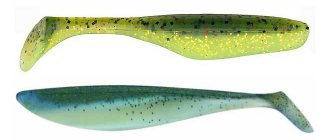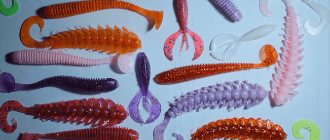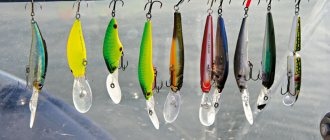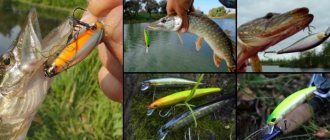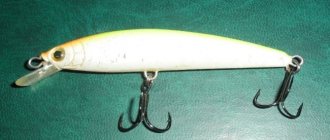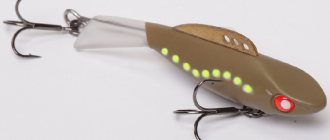Not long ago, silicone baits became a common type of tool among fishermen, as well as those who are interested in winter fishing. It is known that river and lake predators, as well as peaceful ones, are caught using silicone.
What is silicone?
Features of application and classification of silicone baits for fishing in winter
Catching fish with silicone baits is possible from the ice of rivers, lakes, reservoirs, ponds and flooded quarries. As you know, they catch with silicone baits all summer and autumn, and not so long ago they began to use them for winter fishing. Silicone baits or edible rubber have their own classification, size, shape and color.
Types of products made from them:
- worms;
- twisters;
- vibrotails;
- creatures;
- slugs;
- Octopuses.
Hybrid silicone products have appeared on sale. Of these, the most popular are twisters and vibrotails, because they are very similar to live fish, and also attract prey with their movement and bright colors. Most jig lovers often use worms when ice fishing for pike, perch, pike perch, and catfish.
Lures for this fish can be active or passive. Active baits have an elongated shape with a thin oblong body. Passive lures are more like a live worm with no moving parts. These baits include slugs, designed to catch lethargic fish. They work well in thickets, snags and on rocky bottoms.
Octopuses work great in free fall and on super-slow retrieves, actively respond to jerks, and provide a catch at the middle horizons of reservoirs.
Large silicone lures for pike fishing.
Features of silicone baits
Any rubber bait is equipped with a hook, which can be standard or with a cast jig head. The main feature of these baits is the hardness of the material used. The softer it is, the more active the game when fishing. But not all of them are soft and elastic. So, for example, a vibrating tail is made of hard and dense rubber. The reason for this is the pressure at the bottom of a reservoir or river, which can easily damage soft rubber.
The shape of the rubber used is also important. The opinion that catching perch with silicone in winter is most successful using the classic form is erroneous. Other baits that are in no way inferior to standard ones are also used with success. With even wiring, the bait moves and its movement reminds the fish of a well-fed and thick worm, which is sure to interest the perch.
Suitable baits
The switch to silicone for many fishermen is due, among other things, to economic factors - a pack of rubber is definitely cheaper than wobblers, and many spinners too.
Tired of losing expensive balancers, some jig lovers decided to try silicone baits in winter. And the result for many anglers is good, but it is necessary to take into account certain features of winter fishing:
- Silicone should not lose mobility at low temperatures - this is how the play of active elements and body movements of the bait, which provoke the predator to attack, are lost. This problem is most typical for budget tires.
- Lure sizes. As is commonly believed, small silicone is more suitable in winter. 2-3 inches for pike or pike-perch, and 1.6-2, or even cutting baits onto a jig for catching perch. Large silicone tubes, popular among trophy fishing enthusiasts, are less suitable for ice fishing.
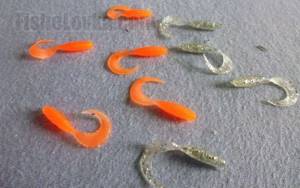
Photo 1. Fine perch silicone.
- Body shape. Although classic vibrotails and twisters are also widely used for ice fishing, summer microjigs such as worms, various larvae, crustaceans or silicone of very exotic shapes are still more popular.
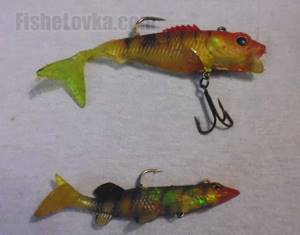
Photo 2. Silicone fish.
- With colors, everything is the same as in the open water season - the most suitable option must be selected already on the reservoir. It is difficult to predict anything here. It is best to have a supply of silicone in both different shapes and different colors - both close to natural color options and bright, acidic ones that provoke an attack by their very appearance.
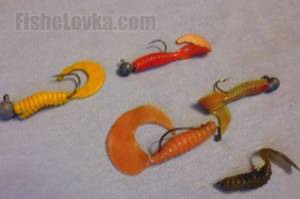
Photo 3. The choice of color can be decisive.
A variety of silicone baits
When entering any specialized fishing store, a fisherman is faced with a huge selection of silicone baits. The provided assortment differs in size, color and shape. The main types of bait for catching perch with silicone in winter are as follows:
- Twisters
- Worms
- Vibrotails
- Slugs
- Creatures
- Octopuses
The most popular are vibrotails and twisters. The latter have a cylindrical shape and a flat tail, which allows them to attract a predator. The first ones imitate the movement of small fish, which is sure to interest the perch.
Worms made of rubber are popular among jig lovers. They are used on different gear and are quite effective when catching predatory fish. There are several types of such baits:
- Active. They are very similar to the classic twister, but have a thin and rather elongated body. They have proven themselves well when catching predatory fish.
- Passive. Externally, the bait looks like an ordinary worm. There are no moving elements. Indispensable when catching predatory fish using jerks.
Slugs are a classic of the passive type. Used in difficult conditions (stones, snags, thickets) for hunting sedentary predatory fish.
Creatures are bait in the form of various underwater objects. The most popular are crustaceans. Used to catch active predators.
Octopuses - used when catching large perch. They have a good response to jerks, and play well during a free fall and not a fast retrieve.
Silicone and rubber
The use of rubber winter lures for perch can significantly expand the angler’s capabilities. They have a number of advantages over other decoys - soft body, low cost and multiple options for equipment. The only drawback is its fragility, especially after an attack by a toothy pike.
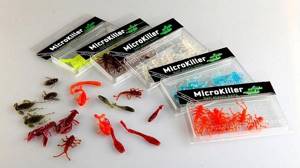
The use of edible rubber for perch in winter is also justified. Of course, it will not work as efficiently as in the summer. In cold water, the flavors with which baits are impregnated do not have the same effect as in summer. However, the impregnation contains salts, which give the angler a couple of extra seconds while the fish thinks about what is in its mouth. An example is the Lucky John Hogy Hog tires. Lures of various shapes, impregnated with a special composition that attracts predators, also work for perch in winter.
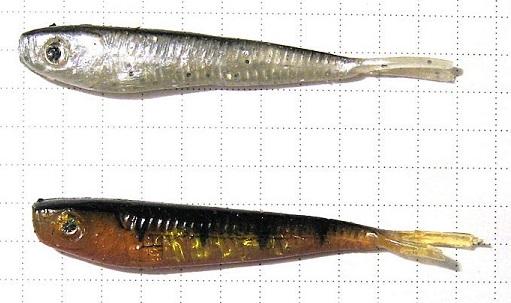
Based on existing practice for winter perch, you can successfully use silicone baits:
- Twisters, vibrotails, fish;
- Slugs, silicone worms;
- Artificial bloodworms, maggots and eggs;
- All other incomprehensible worms and non-existent animals are made of edible rubber;
- Silicone crustaceans;
- Artificial fingerlings.
To catch striped fish, you need to use small and medium-sized baits. Active perch takes fairly large baits well. In the wilderness, it is better to use the smallest options on thin equipment.
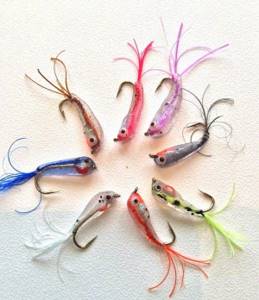
Little pussies
Effect of frost on silicone
When ice fishing with silicone, you need to take into account the resistance of soft rubber to frost, especially severe frost. Special winter rubber baits are still quite rare in stores. Therefore, you have to choose empirically. Silicone can harden in the cold and lose its softness and mobility, which is attractive to fish. However, some silicones feel fine in the cold.
Products made from edible rubber may become covered with an ice crust, as they are in specially impregnated bags. Therefore, it is better to store them in your bosom or in a thermal bag, and when using, quickly attach them and lower them into water. This is probably the main factor, along with low awareness, due to which fishermen do not use such gear very often in winter for perch. However, with proper organization of selection, storage and use on the pond, catching perch with silicone is successful and interesting. Rubber baits can help out when traditional ones are silent.
Type of silicone according to the material used
Catching perch in winter with silicone baits has a number of features. The success of the bite depends on the material used.
There are a couple of types of silicone used:
- “Inedible” baits are the bait that gave impetus to the development of the jig fishing method. It is made of plastic, preheated and poured into pre-prepared molds. There are many options for silicone. All of them are unique in their own way and are used depending on the situation.
- “Edible” baits are a widely used and common type. Used for fishing regardless of the time of year. Made from rubber with amino acid impurities. To attract predatory fish, the material is impregnated with an attractant, which significantly increases interest in the bait. The main disadvantage is the low strength threshold. Sometimes one bite can damage the bait to such an extent that it will need to be replaced.
- Floating baits. There are two types: edible and regular. Their ability to maneuver through water depends on the density of the material. The ability not to sink gives the bait a number of advantages, which include:
- Silicone imitates a fish digging in the ground, which attracts large fish.
- Allows you to carry out wiring without unnecessary movements. The fisherman easily twitches the line, the bait stands in one place, but at the same time imitates the movement of small fish, which attracts even a well-fed predator.
- Good visibility of the material used allows you to fish in troubled waters. The existing color scheme makes it possible to choose bait for any fish. The color of silicone for perch is selected based on a number of factors, which include weather, fishing depth, time of year, etc.
Artificial bloodworms and maggots. Widely used when catching peaceful fish and hungry predators. They look like live bait and have a scent that interests fish, obtained by using aromatic oils.
Equipment options
Winter rigs for silicone baits are very similar to summer rigs, but there are also features characteristic of ice fishing:
- The simplest winter installation is to simply tie a fishing line to the eye of a small jig head of an eared sinker or a large jig. This option is well suited both for exploring the bottom itself and for conducting wiring in the water column.

Photo 5. Installation on a Cheburashka.
- If ice fishing with silicone baits is carried out on a heavily silted area of the bottom, then a slightly different installation is required. For such a section of the reservoir, a rig similar to the drop shot familiar to most spinning anglers is suitable. The sinker is located at the end of the main line, and the hook with bait is tied at a certain distance from it. In this way, you can carry the silicone through the water column, preventing it from burrowing into the silt.
- The option with a sliding hook is also interesting. In this case, the bait is not rigidly fixed to the leash or fishing line. A jig hook is simply threaded into its wide eye with the main fishing line, limiting its freedom of movement with a pair of locking knots. In this case, the movements of the bait will be smooth, which is especially important when catching passive fish in winter.
- Snap-ins with several hooks are also used. In the summer there is practically no point in using such structures, but in winter two or three baits fixed at a certain distance from each other will allow you to simultaneously fish several deep horizons, thus speeding up the search for active fish.
Important! Many anglers consider it necessary to install an additional hook when fishing with silicone in the winter. This is a tee, which is attached near the front of the bait, and significantly improves the implementation of cautious bites, especially from pike perch and pike.
Top 10 silicone baits
In winter, perch can be caught well on silicone using almost all baits. But there are still a number of baits whose ratings are significantly higher than others. We list the most popular of them:
- Reins Rockvibe Shad2.
- Kosadaka Vibra.
- Mann's Predator 70.
- Lucky John Pro Series Mister Greedy.
- Bass Assassin Curly Shad.
- Relax Koryto.
- Fox Rage Fork Tail.
- Lucky John Pike Idol.
- Mann's Stalker 5.5.
- Vibro Worm 3.4.
Tackle for winter perch fishing with silicone
Most anglers when fishing for perch in winter using silicone use ordinary winter fishing rods with a nod. Catching perch with silicone from the ice of time can be done using the following equipment:
- Fishing with rubber using a retractable leash is very simple in design. Can be used on any type of reservoir. The length of the leash is at least 100 cm. When using baits that are small in size and weight, additional weight is used, which can be small lead pellets.
- Drop-shot tackle. The difference between this method and others is the location of the bait and fishing line on different planes. A weight is attached to the end of the fishing line and a knot is tied with a hook on which the rubber bait is fixed.
- Fishing using non-immersed rubber. The method implies the absence of any weighting agent. Only silicone bait and hook are used. A fishing line is tied onto it and the bait is attached. The body of the hook is hidden in silicone.
- Jig heads. It is used with flexible or free fastening, which makes it possible to use a variety of loads. Allows for quick bait replacement. Ideal for catching perch in winter using a silicone microjig.
Edible food during winter fishing
Date: January 10, 2021 | 022
Since it’s not winter yet, it’s worth mentioning one very interesting question: do silicone baits, edibles, work when fishing in winter from ice? Indeed, since one of the main topics of this blog is silicone lures, it’s a good idea to figure out whether they are relevant only in open water for spinning fishing. Or there is an opportunity to successfully catch fish on them all year round, including in winter, from ice, from holes. In this review I will share my thoughts on this topic.
Predatory fish, at least our main freshwater predators, are active in winter. Perch is almost the main winter fish in most of our freshwater bodies. In winter, at times, both pike and pike perch are caught well. Asp, chub, etc. It is very difficult to catch white predators from the ice and this happens rarely. But the burbot turns on. The catfish has been turned off since the onset of the autumn cold snap (if only in places where thermal power plants are discharged, but there is no ice there either...). So, there is someone to catch.
And, if we successfully catch perch, pike and pike perch from the ice using jigs, winter lures, balance beams, etc., why not try fishing with silicone baits and modern edibles. And nothing interferes! Moreover, fish are being caught. The only problem so far is that very few people practice this kind of fishing. There are few experimenters who are ready to challenge the traditional set of winter artificial baits and begin mastering winter fishing with silicone . Well, in order for things to move more actively, let’s look at the features, problems and opportunities faced by a winter fisherman who is planning to pamper a winter predator with some food.
In fact, in the summer we fish with an ultra-delicate spinning rod, a nanojig. They use thin fishing lines, the lightest installations, 90% of which are presented in the form of jigs, weighing up to 1g. We use miniature silicone baits or homemade edible silicone baits. What is stopping us from adapting the same equipment to a winter fishing rod and fishing through the hole, from the ice, using mainly the vertical component of the game. Yes, nothing interferes! And if you are fishing for pike or pike perch, then it is quite possible to fish with larger silicone baits, 2” and 2.5” in size, and maybe even larger.
The simplest version of fishing gear for edibles in winter will look like this. Essentially, this is a winter jig rig for vertical fishing. And now I’ll briefly tell you how to do it. An ordinary light, short winter fishing rod with a reel or reel. Thin fishing line, as we usually use in winter. If for perch, then 0.06-0.08mm, if for pike or pike perch, then 0.12-0.14mm. To the end of the fishing line we tie a jig or a gram eared fish with a small single hook. We attach an inch twister or some other silicone of comparable size to the hook. That's all. We drill a hole, fish the bottom layer, sometimes tearing the bait from it, sometimes trampling along the very bottom.
Yes, if we are talking about targeted hunting for winter pike, you should limit yourself to one bait. Take something larger for this quality, 2.5”, 3”, maybe even more. I prefer narrow-bodied edible vibrotails. And, of course, place a small leash made of the finest steel in front of the bait.
If the bottom is heavily silted, or the fish does not take from the very bottom, then it makes sense to look for it a little higher. To do this, we will make a tackle that essentially resembles a drop shot. At the end of the line we tie a weight, usually a little heavier than we would use just for jigging. And above, 30-50cm from the sinker, there is a hook. And on the hook we put the same miniature silicone, or a cut of edible food.
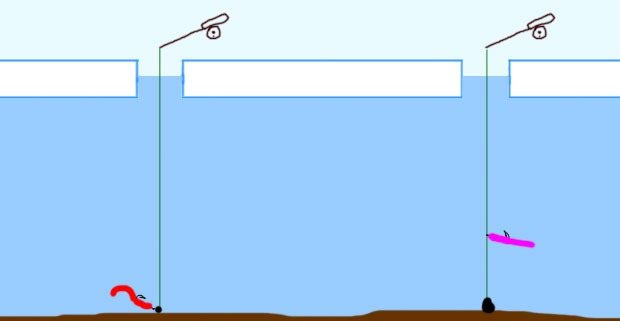
And with these two simple, and, in principle, obvious installations, you can successfully catch predatory fish in winter, from holes, using silicone baits.
By the way, about the aforementioned delicate winter drop shot. You can tie not one hook, but 2-3. And fish with different baits in different layers of water. You can tie the hooks directly to the fishing line, or you can form short leashes to give the bait more liveliness. This, it turns out, is already a garland. Only in the summer we drag it along the bottom, but here we work in a vertical plane. In fact, this is a tyrant, well known to those who fish in the sea. In particular, fish such as smelt are caught using this kind of tyrant, only pieces of colored gum (cut condoms...) or colored threads are used as bait. So, what we will use for our traditional predators is just a slightly larger version of the long-known rigs.
There are several options for tying such leashes. The first and simplest. We string 2-3 hooks onto the fishing line. Stings towards the end of the line. We grab the ring of each hook with a single knot. We form a short leash and secure it with a double knot. This leash made of double fishing line has a length of 3-6 cm.
The second option is to simply tie a short leash with a hook to the main fishing line. You can simply splice it with a knot or connect it in a loop-to-loop manner.
Which lures from the wide variety of silicone are relevant to use in winter, when ice fishing. Small twisters and vibrating tails work well. The tails of these active baits work both on the rise and on the fall. The size of such baits greatly depends on the size of the fish and its behavior. If you catch small and medium-sized perch, then use baits of 1”, 1.5”, 2”. And if they catch pike perch, pike, or catch a large perch, then larger tires are used.
In addition to twisters and vibrotails, you can use slugs, crayfish, and silicone worms. Those. full set.
Since small-sized baits (1-1.5”) are not so common, cutting is often used. We simply take a sharp knife or blade and cut narrow strips from large edibles (worms, slugs, vibrotails). This is how you get homemade silicone worms or slugs. By holding and playing with these baits using short pulsating movements in the vertical plane, they provoke the fish to attack.
In addition to classic edibles and slicing, in winter it is important to use silicone imitations of bloodworms, maggots, and various nymphs. Also, there are baits such as caviar made from edible silicone. And this is also worth trying to catch.

Since frost has a bad effect on silicone and can freeze it with an icy crust at the slightest exposure to air, you should be careful about this point. Keep packs of edibles and slices warm, in your breast pocket. And the baits that are in use must be warmed up and the ice crust removed if it has managed to form during the process of manipulating the tackle.
There is one point that is also worth pointing out. Edible silicone works in winter, alas, mainly after the bite, when the bait is already in the mouth of the fish. The fact is that in cold water attractant particles spread extremely poorly when compared with warm water in the summer. This comes from the characteristics of the diffusion process. Microparticles mix more actively as the temperature of the medium increases. So, the factor of attracting fish from a distance by the smell of bait is almost completely neutralized. But when the fish grabs, its receptors sense the attractive composition of the attractant and the presence of salts. And the fish tries to hold on and swallow such bait more actively. Hence the conclusion that it is better to use a full-fledged edible product in winter, or cut from it, than regular silicone, or simply anointed with an attractant. So, when ice fishing, I would advise using edible silicone from leading Japanese brands, saturated with both attractant and salts.
Fishing in winter, in holes, with a slight current may be more interesting. If fishing takes place in still water, then the angler is very limited and can only fish a small area of the bottom, which is directly under the hole. If there is a current, then it becomes possible, by changing the weight of the weight and manipulating the swings of the fishing rod, to fish a certain strip along which the current carries the tackle.
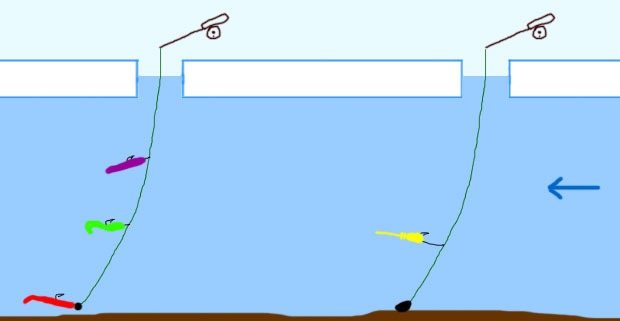
Also, you can diversify your fishing if you drill directly above a fairly steep drop or edge. Then you can fish some area with variable depth, jumping along the slope.
Thus, you can try fishing in winter, from holes, with our usual summer silicone baits! I do not urge all winter travelers to urgently abandon their usual winter spinners and balancers and switch to silicone fishing. No! But, at a minimum, diversify and experiment. Periodically trying to fish in winter with such baits is very worth it. At least put edible fish on the hooks of classic winter baits and combine them.
Share with your friends:
Categories: Fishing for food · Tags: Winter, Places, Perch, Lures, Pike-perch, Edible, Equipment, Pike
Winter fishing technique with rubber
In order to lure perch during winter fishing, avid fishermen use all sorts of tricks and methods. The main methods are:
- Various taps of the bait on the bottom.
- Drops and various bait tosses.
- Lowering and raising the tires at different speeds.
- Twitching and playing with bait.
Each of these methods is unique, has its own implementation characteristics and effectiveness, which depends on many factors. The final choice of method is made on the pond depending on the bite, weather conditions, etc.
The number of useful and informative videos about winter perch fishing is varied. We invite you to watch an educational video from an experienced fisherman about how to catch perch and what bait to choose.
Catching perch with silicone video
How to catch perch using vibrotails
Fishing for vibrotails is not particularly difficult. The main thing is to find a quiet place and enjoy the fishing process.
Vibrating tail wiring
For inexperienced spinning players, it would be more correct to use uniform wiring. It is important to correctly determine the fishing horizon by experimenting and continue fishing at this depth.
If there is no bite while retrieving, it is useful to make small jerks. As a result, the vibrotail will resemble a runaway fry. Such simple actions often bring results, forcing the striped fish to attack the bait.
Experienced fishermen prefer stepped fishing. The fishing horizon depends on the time of year. In warm water, it is more effective to make a step in the middle layer and above, and in the cold season - near the bottom.
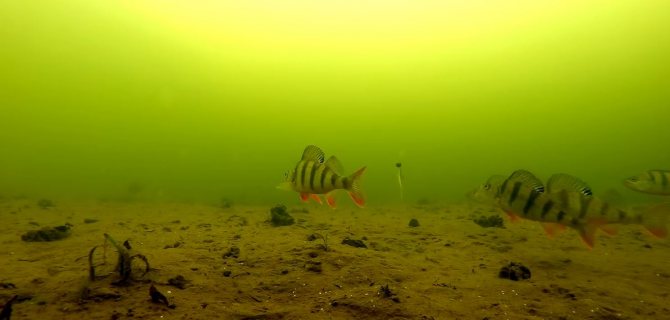
For a passive predator, the method of dragging along the bottom works, but this requires a clean area of the bottom surface. Pauses, which can last up to a minute, have a positive effect on the bite.
Fishing Features
The nature of catching perch of different sizes is radically different. Small and medium-sized stripers need to be caught on a fast retrieve. They have strong food competition, as a result of which the predator loses caution and grabs without delay. The main thing is to get ahead of your relative.
Large perch, on the contrary, is a loner. To persuade him to bite you need to try hard. Lethargic action with lots of pauses is the best way to catch trophy bass.
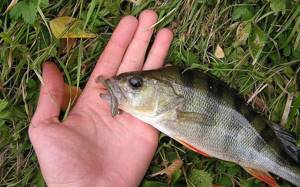
The water temperature also significantly affects the bite. In warm water the metabolism is higher and the fish need to eat more often. In cold water, the need for food decreases, and the predator will think: try to catch up with small small prey or save energy.
Where and how best to store silicone
Any fishing with a spinning rod involves the use of silicone baits. For a long time, fishermen have collected a wide variety of baits in their fishing box. If storage rules are not followed, they change color, shape, rot and fall into pieces. Residual water on the material exposes metal parts to corrosion, as a result of which they can lose strength and break when bitten by a large individual. Therefore, storage of nozzles must be carried out in accordance with all requirements.
4 rules for storing silicone baits
Storing bait requires compliance with certain rules. Each type has its own characteristics. Let's talk about each of them in more detail.
Storing silicone bait
In order for silicone baits to have a long service life, you must adhere to a number of simple recommendations:
Storing edible baits
There are two types of edible materials used on spinning rods:
- Lures made of silicone and impregnated with attractants. The impregnation process is carried out after receiving the finished product.
- The production of bait with a silicone odor is made from pre-scented materials.
The process of preparing to save such attachments includes the following steps:
- Clean the product from existing contaminants - rinse for a long period of time.
- Defects are eliminated and given their original shape - heated under warm water and straightened to the required lines.
- Perform thorough drying.
- Existing cracks and tears are repaired using a turbocharged lighter.
After completing all the above points, the bait is placed in a packaging container and sent for storage.
How to store rubber baits
Silicone baits can be stored in the following containers:
- The food container is convenient to use. The downside is the need for no empty space. Excess free air negatively affects the quality of silicone.
- Factory packaging. A very convenient storage option. It is ideal for materials with odors. Prevents weathering and drying out.
- Specialized fishing boxes. The main advantage of this option is the presence of a large number of compartments, allowing you to sort bait by color, shape and size.
- Fishing boxes. Plus - capacity and tight-fitting lid, providing protection from ultraviolet radiation. The downside is the size of the box.
Features of winter storage
To store silicone in winter, it is necessary to perform a number of operations: washing, cleaning from dirt, removing foreign odors and drying. After completing the above operations, the silicone is placed in the required container and stored at a temperature of +5...+8°C.
As you can see, storing silicone bait is a rather complex and time-consuming process that requires compliance with a number of factors. The maximum shelf life of silicone bait is 3-5 years. This period depends on storage conditions. Therefore, choose and use the method that suits you best.
If you know any other good way to store bait, please share it, maybe it will be useful to someone.

